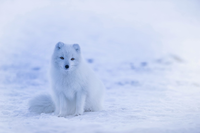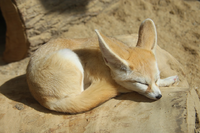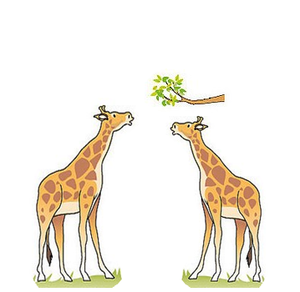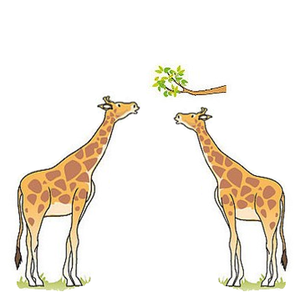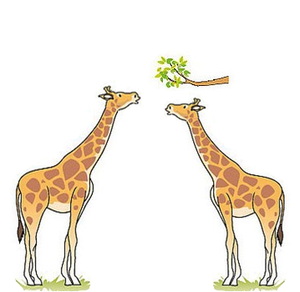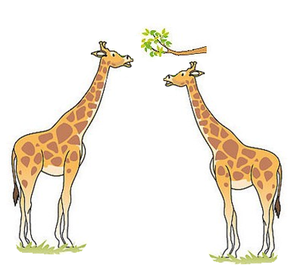Evolution by Natural Selection
Key Stage 2
Meaning
Evolution means a change over time. All species on earth evolve.
About Evolution
- The different types of creatures we see today looked different millions of years ago. The creatures have evolved.
- A single animal or plant does not evolve. A whole population evolves over many generations.
- Evolution can be shown by looking at fossils of creatures that lived millions of years ago.
Examples
| The giraffe used to have a short neck. Over many generations the population of giraffes had longer and longer necks. |
| Arctic Fox | Desert Fox |
| The Arctic Fox has evolved to have thick white fur and small ears. | The Desert Fox has evolved to have thin sandy coloured fur and very large ears. |
Key Stage 3
Meaning
Evolution by natural selection is the process by which new species are formed over thousands of generations.
About Evolution by Natural Selection
- Evolution by natural selection is caused by two important factors; variation and heredity.
- A species will have variation between organisms in the population. This means they will all be slightly different.
- Some variations are hereditary which means they are passed on from parent to offspring.
- If a heritable variation gives a member of the species an advantage over the others in its environment, then it is more likely to survive and reproduce. This is natural selection where some variations cause organisms to die while other variations cause organisms to have more offspring.
| Millions of years ago all Giraffes had short necks. Variation meant some Giraffes were a little bit taller than others. Those Giraffes could get to the higher leaves in trees. This meant they could eat more. The shorter Giraffes couldn't get enough food and died. So the taller Giraffes survived and their offspring inherited their slightly longer necks. | After a few generations all the giraffes had slightly longer necks, but because of variation some had even longer necks still. This meant they they were more likely to get food, survive and have children than the shorter giraffes. So their offspring inherited these even longer necks. |
| This process of natural selection is repeated again and again causing a gradual evolution. | Millions of years later, after many generations, eventually all the Giraffe had very long necks. |
| This picture shows a series of human skulls starting on the left with a skull from 20 million years ago through to a modern human skull. |
Key Stage 4
Meaning
Evolution by natural selection is the process that leads to new species being formed over thousands of generations.
About Evolution by Natural Selection
- Evolution by natural selection is caused by two important factors; variation and heredity.
- A species will have variation between organisms in the population. This means they will all be slightly different.
- Some variations are hereditary which means they are passed on from parent to offspring.
- If a heritable variation gives a member of the species an advantage over the others in its environment, then it is more likely to survive and reproduce. This is natural selection where some variations cause organisms to die while other variations cause organisms to have more offspring.
- Variation can be caused by random mutations which occur during reproduction. If that mutation provides an advantage to that organism over others in the species then it will have more offspring than others spreading that beneficial mutation. Over several generations that mutation will be spread throughout the species. Over time many of these mutations occur changing the entire population until they are no longer the same species as they were prior to these mutations.
Development of the Theory of Evolution
Creationism
- Before a theory of evolution Christians believed that all the species on Earth were created in their current form just 6000 years ago when the Earth was created by a God. (They arrived at this number by adding up the ages of the descendants of Adam and Eve until Jesus.)
Lamark's Theory of Evolution
- In the early 19th century Jean-Baptiste Lamark developed a theory of evolution. However, he did not propose natural selection as the cause.
- Lamark believed that the behaviour and environment of an organism would cause it to change in its lifetime and those changes could be passed on to their offspring.
- He suggested that the evolution of the giraffe was caused by many generations of giraffe stretching their necks to reach higher food. When a giraffe stretched its neck then the offspring would also have longer necks.
- Jean-Baptiste Lamark believed that all species began as simple worms which would spontaneously appear and over time their behaviour and environment would change them and pass that change onto their offspring.
- Jean-Baptiste Lamark was right that species evolve over generations, but wrong about the cause.
Charles Darwin "On the Origin of Species"
- Charles Darwin took Lamark's theory of evolution and proposed a different cause.
- When visiting the Galapagos Islands Darwin noticed that on each island there were a group of birds called Finches which has slightly different features on each island.
- The environment on each island was slightly different and those features seemed to make the Finches perfectly suited to their own island.
- Darwin proposed this was caused by Natural Selection which was based on three observations:
- There is variation within a species.
- Variations can be passed down from parent to offspring.
- Populations always produce more offspring than the environment can support which causes competition.
- This means that those with beneficial adaptations will be more likely to survive and reproduce. The environment will naturally select which organisms will pass on their features.
- Darwin recognised that people would not believe him so he set out gathering and sorting evidence for his Theory of Evolution by Natural Selection.
Evidence for Evolution
There are a number of independent lines of evidence for Evolution by Natural Selection:
- Comparative Anatomy - Many species have similar features suggesting they evolved from the same ancestor. This was the case with Darwin's finches. They all had similar features with some slight modifications.
- Fossil Records - Fossils of ancient creatures shows how their features gradually changed over millions of years. Fossils of extinct creatures show similar features to some current living creatures. This is the case of dinosaur fossils and modern birds.
- DNA - The DNA of different species shows how they are related to one another and can be used to trace the features of a common ancestor. This is the case for humans and other great apes.
- Antibiotic Resistance - Since the invention of antibiotics it has been observed that bacteria have evolved by natural selection to become immune to the effects of the antibiotics.
References
AQA
- Evolution by natural selection, pages 96, 97, 102, GCSE Biology; The Revision Guide, CGP, AQA
- Evolution, page 234, GCSE Combined Science Trilogy; Biology, CGP, AQA
- Evolution, pages 184, 211-17, GCSE Biology, Hodder, AQA
- Evolution, pages 200, 220-221, 234-255, GCSE Biology; Third Edition, Oxford University Press, AQA
- Evolution, pages 273, 276-91, GCSE Biology; Student Book, Collins, AQA
- Evolution, pages 286, 290, 291, GCSE Biology, CGP, AQA
- Evolution, pages 68, 75, GCSE Combined Science Trilogy 2, Hodder, AQA
- Evolution; Evidence for, pages 59-62, GCSE Combined Science Trilogy 2, Hodder, AQA
- Evolution; evidence, pages 218-22, GCSE Biology, Hodder, AQA
Edexcel
- Evolution, pages 125-135, GCSE Biology, CGP, Edexcel
- Evolution, pages 32-34, GCSE Combined Science; The Revision Guide, CGP, Edexcel
- Evolution, pages 45-48, GCSE Biology; The Revision Guide, CGP, Edexcel
- Evolution; Darwin’s theory, pages 58-59, GCSE Combined Science, Pearson Edexcel
- Evolution; Darwin’s theory, pages 78-79, GCSE Biology, Pearson, Edexcel
- Evolution; faster evolution, page 59, GCSE Combined Science, Pearson Edexcel
- Evolution; faster evolution, page 79, GCSE Biology, Pearson, Edexcel
- Evolution; human evolution, pages 56-57, GCSE Combined Science, Pearson Edexcel
- Evolution; human evolution, pages 76-77, GCSE Biology, Pearson, Edexcel
- Evolution; of humans, pages 130-134, GCSE Biology, CGP, Edexcel
OCR
- Evolution, page 73; evidence for, page 74, Gateway GCSE Biology; The Revision Guide, CGP, OCR
- Evolution, pages 168-173, Gateway GCSE Biology, Oxford, OCR
- Evolution, pages 54-55, Gateway GCSE Combined Science; The Revision Guide, CGP, OCR
- Evolution; bacteria, page 169, Gateway GCSE Biology, Oxford, OCR
- Evolution; evidence for, page 55, Gateway GCSE Combined Science; The Revision Guide, CGP, OCR
- Evolution; evidence, pages 169-171, Gateway GCSE Biology, Oxford, OCR
- Evolution; natural selection, pages 168-169, 173, Gateway GCSE Biology, Oxford, OCR
- Evolution; phylogeny, page 175, Gateway GCSE Biology, Oxford, OCR
- Evolution; theory, Gateway GCSE Biology, Oxford, OCR

